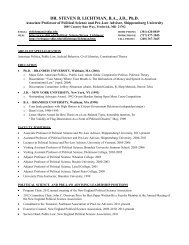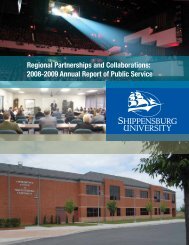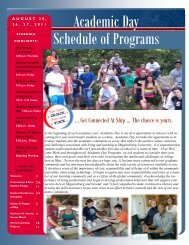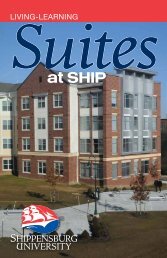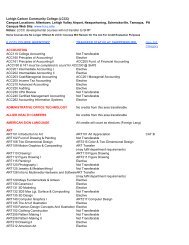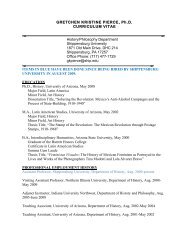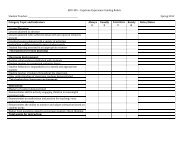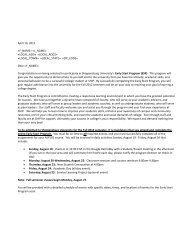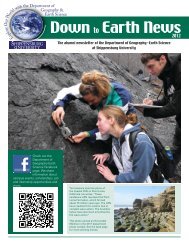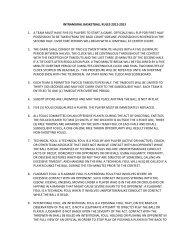Complete Issue - Shippensburg University
Complete Issue - Shippensburg University
Complete Issue - Shippensburg University
- No tags were found...
You also want an ePaper? Increase the reach of your titles
YUMPU automatically turns print PDFs into web optimized ePapers that Google loves.
24 PROTEUS: A Journal of Ideasraised about whether this will prove to be true of therecently-appointed regional water planning councils. 17The second is the geography of regional planning.While resource assessments are to be conductedfollowing hydrologic boundaries, regional planning foruse of those resources will follow jurisdictional (county)lines rather than watershed lines. This approach reflectsthe reality of managing a system with natural andengineered features, but effectively marrying the twodifferent geographies remains a challenge in regionalplanning.For now, the long-run prognosis for changes inGeorgia’s water management institutions and the longtermoutcomes that may result remain open questions.But, the experiment has been engaged, changes areunderway, and the results will certainly bear watching.ENDNOTES1. The authors of this paper were actively involved in thestatewide water planning process. As a policy adviser with theagency that led plan development, G. Cowie was among the corestaff responsible for the project. As contractors to that agency, L.Askew and C. Tobin coordinated facilitation of the Basin AdvisoryCommittees, were principal facilitators for the StatewideAdvisory Committee, and assisted with public meetings.2. See, for example, Pennsylvania Department of EnvironmentalProtection, Pennsylvania State Water Plan, www.depweb.state.pa.us/watershedmgmt/lib/watershedmgmt/state_water_plan/background/2007_06_swp_update_info_sheet.pdf (accessedMarch 19, 2009) and Virginia Department of EnvironmentalQuality, State Water Plan, www.deq.state.va.us/watersupplyplanning/statwat.html (accessed March 19, 2009). \3. Florida Department of Environmental Protection, AnnualStatus Report on Regional Water Supply Planning and WaterResource Development Work Programs 2003, http://www.dep.state.fl.us/water/waterpolicy/docs/RWSP_ASR_2003.pdf(accessed March 19, 2009).4. Florida Department of Environmental Protection, Learningfrom the Drought, Annual Status Report on Regional WaterPlanning, August 2008, http://www.dep.state.fl.us/WATER/waterpolicy/docs/learning-from-drought-final-report.pdf (accessedMarch 19, 2009).5. South Carolina General Assembly, 118th Session, 2009-2010,H. 3132, http://www.scstatehouse.gov/sess118_2009-2010/bills/3132.htm (accessed March 19, 2009).6. International Business Times, “Alabama State Legislators toBegin Writing Water Plan,” http://www.ibtimes.com/articles/20080724/alabama-legislators-to-begin-writing-water-plan.htm (accessed March19, 2009) and the Huntsville Times, “MoreWater Data Needed for Plan, Panel Chief Says,” http://www.al.com/news/huntsvilletimes/local.ssf?/base/news/1233137751314120.xml&coll=1 (accessed March19, 2009).7. Official Code of Georgia Annotated §12-5-520 et. seq.8. Official Code of Georgia Annotated §12-5-5229. See Georgia Environmental Protection Division,Acknowledgements, “June 28, 2007 Draft of Georgia’s WaterResources: A Blueprint for the Future,” http://www.georgiawatercouncil.org/Documents/plan.html for a full list ofmembers (accessed February 10, 2009)10. Georgia Environmental Protection Division, GeorgiaStatewide Water Planning: State Water Plan Development:2005-2008, http://www.georgiawaterplanning.org/Documents/background.html (accessed February 10, 2009).11. Mail survey designed and conducted by L. Askew, C.Tobin,and R. Rawls, Fanning Institute, <strong>University</strong> of Georgia.12. See, for example, Judith Innes, Sarah Connick, and DavidBooker, “Informality as a Planning Strategy,” Journal of theAmerican Planning Association 73, no. 2 (2007): 195-210; ElinorOstrom, Governing the Commons: The Evolution of Institutionsfor Collective Action (New York: Cambridge <strong>University</strong> Press,1990); Sandra Postel and Brian Richter, Rivers for Life: ManagingWater for People and Nature (Washington, DC: Island Press,2003); and Joanna Burger, Elinor Ostrom, Richard B. Norgaard,David Policansky, and Bernard D. Goldstein (eds.), Protecting theCommons: A Framework for Resource Management in theAmericas (Washington, DC: Island Press, 2001).13. Kai N. Lee, Compass and Gyroscope: Integrating Science andPolitics for the Environment (Washington, DC: Island Press,1993); Steven E. Daniels and Gregg B. Walker, Working ThroughEnvironmental Conflict: The Collaborative Learning Approach(Westport, CT: Praeger, 2001); and John T. Scholz and BruceStiftel (eds.), Adaptive Governance and Water Conflict: NewInstitutions for Collaborative Planning (Washington, DC:Resources for the Future, 2005).14. Lawrence Susskind, “Resource Planning, Dispute Resolution,and Adaptive Governance” in Adaptive Governance and WaterConflict: New Institutions for Collaborative Planning, ed. John T.Scholz and Bruce Stiftel, 142 (Washington, DC: Resources for theFuture, 2005).15. Paul Sabatier, Will Focht, Mark Lubell, Zev Trachtenberg,Arnold Vedlitz, and Marty Matlock (eds.), Swimming Upstream:Collaborative Approaches to Watershed Management(Cambridge, MA: MIT Press, 2005).16. Thomas Dietz and Paul C. Stern (eds.), Public Participation inEnvironmental Assessment and Decision Making, (Washington,DC: National Academies Press, 2008).17. See, for example, Athens Banner-Herald editorial “Regionalwater councils will need close watching,” www.onlineathens.com/stories/021709/opi_389644614.shtml (accessed March 19,2009).



